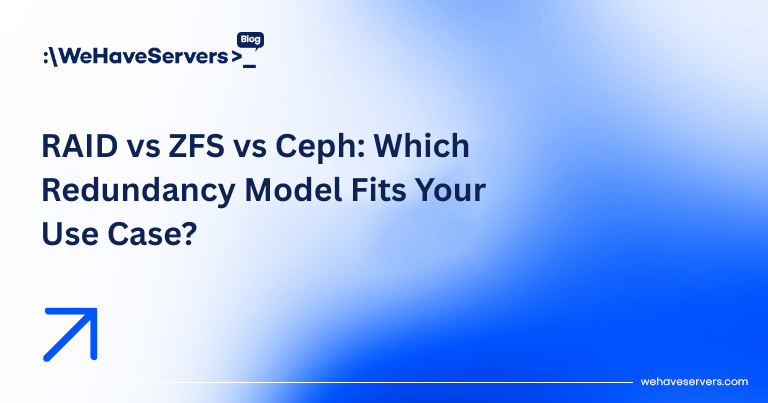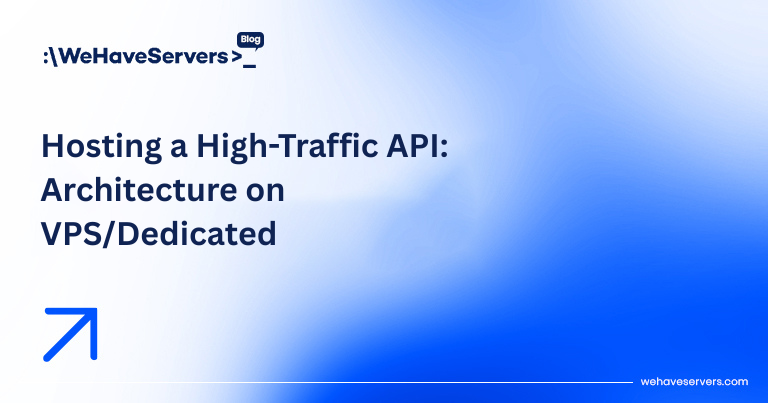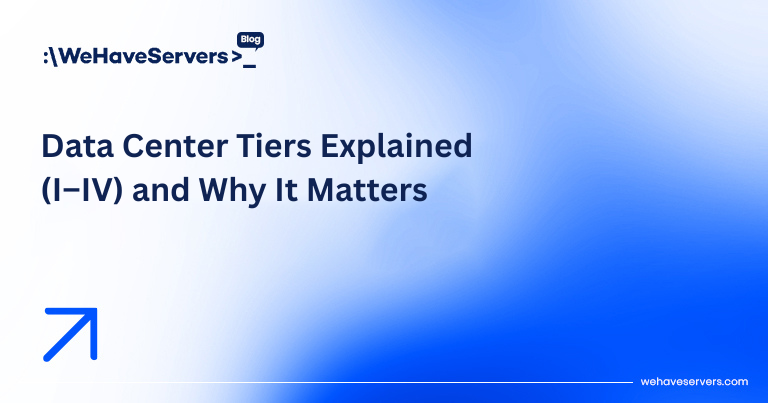
RAID vs ZFS vs Ceph: Which Redundancy Model Fits Your Use Case?
RAID vs ZFS vs Ceph: Which Redundancy Model Fits Your Use Case?
When building infrastructure in 2025, storage is more than just capacity. Redundancy and reliability determine whether your platform can withstand disk failures, bit rot, or even full node crashes. Three of the most widely deployed redundancy models are RAID, ZFS, and Ceph. Each solves data integrity in different ways — and choosing the wrong one can cost you uptime, performance, and money.
This article provides an in-depth comparison of RAID arrays, ZFS storage pools, and Ceph distributed clusters. We’ll cover architecture, strengths, weaknesses, and practical examples so you can decide which model fits your VPS, dedicated server, or colocation project.
🔹 RAID: The Classic Approach
RAID (Redundant Array of Independent Disks) is a long-standing technology implemented in hardware controllers or software (mdadm, Windows Storage Spaces).
Popular Levels:
- RAID 1: Mirroring. Simple redundancy, halves usable capacity.
- RAID 5: Striping with parity. Good balance of redundancy and efficiency, but slow rebuilds.
- RAID 6: Dual parity. Survives 2 disk failures, popular in SATA/NL-SAS arrays.
- RAID 10: Stripe of mirrors. Excellent performance + redundancy, but 50% efficiency.
Strengths:
- Mature, widely supported by OS/hypervisors.
- Predictable performance (esp. RAID 10 for databases).
- Easy to implement with hardware controllers.
Weaknesses:
- No protection against silent data corruption (bit rot).
- Rebuilds on large drives (10–20 TB) can take days, exposing risk windows.
- Scales poorly beyond a single chassis/controller.
🔹 ZFS: Copy-on-Write Storage with Checksums
ZFS, originally from Sun Microsystems, is a filesystem and volume manager in one. It introduces end-to-end checksumming, copy-on-write (CoW), and advanced data management.
Core Features:
- Copy-on-Write: Prevents in-place overwrites, eliminating write-hole issues.
- Checksums: Every block validated against bit rot.
- RAID-Z: ZFS-native redundancy (RAID-Z1, RAID-Z2, RAID-Z3).
- Snapshots & Clones: Instant, space-efficient point-in-time copies.
- Send/Receive: Efficient replication between servers.
Strengths:
- End-to-end integrity. Detects & fixes silent corruption.
- Excellent for databases, VM storage, NFS/iSCSI exports.
- Built-in compression, deduplication (though heavy on RAM).
Weaknesses:
- Memory hungry (rule of thumb: 1 GB RAM per TB storage).
- Scaling limited to a single server — not distributed.
- Expanding pools is not as flexible as Ceph.
🔹 Ceph: Distributed Storage at Scale
Ceph is a distributed object, block, and file storage system. Instead of local redundancy, it distributes data across many nodes with replication or erasure coding.
Core Components:
- OSDs (Object Storage Daemons): Store data chunks across disks/nodes.
- MONs (Monitors): Cluster state management and consensus.
- CRUSH Map: Algorithm controlling data placement.
- RADOS: Reliable Autonomic Distributed Object Store layer.
Features:
- Scales horizontally — from a few TB to petabytes.
- Self-healing: if disk/node fails, data rebalanced automatically.
- Provides block devices (RBD), object storage (S3), and file (CephFS).
Strengths:
- Ideal for cloud platforms (OpenStack, Proxmox, Kubernetes).
- No single point of failure.
- Flexible redundancy: 3x replication or erasure coding for efficiency.
Weaknesses:
- Complex to deploy and operate (needs automation + monitoring).
- High hardware overhead (CPU, RAM, network 10–25G+).
- Latency higher than local RAID/ZFS for small workloads.
🔹 Performance Benchmarks (2025 Snapshot)
| Workload | RAID 10 (NVMe) | ZFS RAID-Z2 (NVMe) | Ceph (3x Replication, NVMe) |
|---|---|---|---|
| IOPS (4K random read) | 1.2M | 1.0M | 750k |
| Throughput (1M sequential) | 7 GB/s | 6.5 GB/s | 4.5 GB/s |
| Latency (avg) | 0.2 ms | 0.3 ms | 1.2 ms |
| Scaling beyond single node | No | No | Yes |
Interpretation: RAID/ZFS outperform Ceph locally, but Ceph wins in distributed scaling.
🔹 When to Use Each
Use RAID If:
- You need simple redundancy inside a single server.
- Workloads: databases, web servers, single-node apps.
- Budget: low.
Use ZFS If:
- You want integrity + snapshots + replication on one server.
- Workloads: VPS nodes, VM hosting, storage appliances.
- Budget: moderate (RAM-heavy).
Use Ceph If:
- You need distributed, scalable storage for cloud or Kubernetes.
- Workloads: multi-tenant VPS, OpenStack, Proxmox clusters.
- Budget: high (network + node overhead).
🔹 Real-World Examples
Case 1: VPS Provider with RAID 10
- Each node runs RAID 10 NVMe arrays.
- Fast performance, but scaling limited to node size.
Case 2: Enterprise Backup Server with ZFS
- RAID-Z2 pool with compression enabled.
- Efficient, safe against bit rot, supports snapshots for compliance.
Case 3: Cloud Provider with Ceph
- Ceph cluster with 100+ nodes.
- RBD block devices for VM disks, CephFS for shared storage.
- Survived multiple node failures with zero downtime.
✅ Conclusion
RAID, ZFS, and Ceph are not interchangeable — they serve different scales and risk models. For a single dedicated server, RAID 10 may be enough. For VM nodes or enterprise NAS, ZFS offers unmatched data integrity. For distributed cloud and petabyte-scale systems, Ceph is the clear choice.
The right choice depends on:
- Scale: Single node vs cluster.
- Budget: Commodity vs enterprise.
- Criticality: Data loss tolerance and uptime SLA.
At WeHaveServers.com, we deploy RAID, ZFS, and Ceph depending on client needs — from simple dedicated servers to large-scale Proxmox clusters with Ceph backend.
❓ FAQ
Does RAID protect against bit rot?
No. RAID can only rebuild from parity/mirrors. It does not checksum blocks. Use ZFS for integrity.
Is ZFS better than hardware RAID?
In many cases yes. ZFS integrates filesystem + redundancy and avoids RAID write-hole issues.
Is Ceph overkill for a small VPS?
Yes. Ceph is resource-heavy. Better suited for multi-node environments.
Can I combine RAID and ZFS?
Not recommended. ZFS wants raw disks. Let ZFS manage redundancy directly.
Which is fastest?
Locally, RAID 10 and ZFS on NVMe. Distributed, Ceph is slower but scales infinitely.



